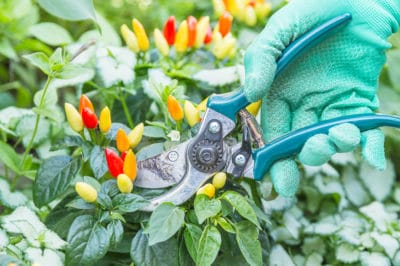What is Topping?
‘Topping’ is a technique that some gardeners use on pepper plants. The main stem or tip of the plant is cut before the plant gets tall. The stem is cut above two healthy branch nodes. Topping stops upward growth through the main stem and redirects energy into the branches.
The growth hormones auxin and gibberellins concentrate in the tips of pepper plants. They send signals to produce new growth which is why the plant gets taller. When you top a pepper, the hormones move from the tip into the nodes just below your cut. They send signals which stimulate the growth of these branches. The plant will branch and “Y” out rather than get taller.
Pepper plants tend to grow tall and leggy naturally. Gardeners growing them in containers, small spaces, or without support infrastructure benefit from bushier plants rather than taller plants. Topping encourages bushy growth.
Does It Increase Yield?
Some pepper varieties respond better to topping than others. Small chilis are the most popular to top. They will produce the best results. Topping discourages lengthening which results in nodes that are closer together. Closer nodes mean there are more nodes in a smaller area.
The idea is that more nodes mean more flowers and more fruit. It is controversial whether topped pepper plants produce more fruit compared to naturally grown peppers. Studies with bell peppers actually resulted in decreased yields overall. It is agreed that topped plants are generally stronger, shorter, and produce higher quality fruits.
If staking or caging peppers works well in your garden, there is little reason to top plants. Plants that are not topped but pruned only for light and sucker reduction are healthy and productive. Top pepper plants for the following reasons:
- For larger, higher quality fruits
- For shorter, bushier plants
- In small spaces and short greenhouses
How to Top Pepper Plants
Top at any time throughout the life of a pepper plant. Typically the first main cut is made when the plant is still a seedling under 12 inches tall. Cut the main stem above any set of healthy looking branches. The branches below the cut will become the new main stalks of the plant.
It will take a few days for the plant to recover and reroute growth hormones. You’ll notice new growth popping out of the nodes below the cut. As the new branches get long, you can repeat the process and top them. Each branch cut will “Y” and the more cuts you make the bushier the plant will become.
Top the plant as many times as desired. Pay attention to how the plant is branching. If there are areas that seem empty, cut above branches that grow in those directions to fill in open spaces. Cut out branches that cross each other or prevent light from reaching inner leaves.
Other Pruning
In addition to topping, other pruning methods will help keep plants vigorous. Suckers poke out between branches at the crook of the “Y”‘s. These are not fruiting branches, they are propagative growth. They will take energy from the fruiting nodes of the plant and should be cut out.
Trim and remove branches or leaves that prevent light from penetrating the plant. In particular, remove leaves that block light from reaching budding nodes. Maximum light exposure will produce healthier plants and higher yields.
Late in the season as the last of the fruit hangs ripening on the plants prune peppers to put energy into the last fruits. Cut back all non-fruiting branches to the stem. Also, prune away any flowers or unripe fruit that won’t have a chance to ripen.
Keep Your Cuttings
All of the tops, branches, and suckers cut off your pepper plant can become new pepper plants. Remove them carefully and stick them into a cup of water. You can add rooting hormone to the water for better results but it isn’t necessary. Leave the cuttings in water with plenty of sunlight for a few days until they sprout new roots.
Once a small root system is established, plant each cutting into its own pot. This is a new pepper plant and can be treated, pruned, topped, and harvested as any other plant.
